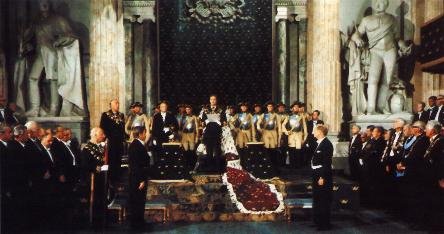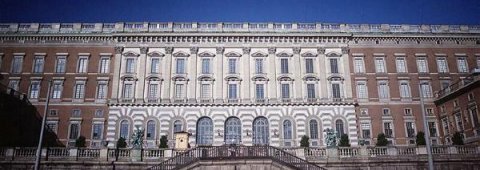
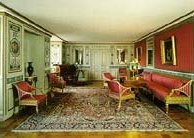

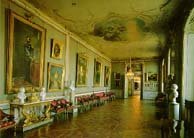
The Guestroom got it's present decoration in the 1790ies. This part of the palace was once used by king Gustaf III's younger brother, duke Frederic Adolph.
The Pillared Hall was created in the 1730-ies by Carl Hårleman. The Ceiling painting was made by the Italian Allessandro Feretti.
The Bernadotte Gallery, of original room it's just the ceiling painting of Taravals, a chimney, window and some door sections. It's present name the gallery got because it houses portraits and other objects connected with the Bernadotte family.
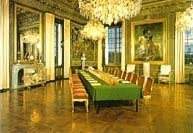

The Cabinet Meeting rooms décor was mainly created in the 1900th century. The splendid door on the right is however still present from Tessin's original decoration in the 1800th century, and is a good example of the Frenchman Henrion's art.
The Antique "museum" was ordered in 1958 by king Gustav VI Adolf, but it's still one of Europe's oldest museum, because the art collection was bought during Gustav III's Italian travels. The collection was extended to the National Museum after the kings murder in 1792.
The Mirror Room of Carl XV was created in 1859 by F.W. Scholander in new Baroque style.
The dining room have changed during the centuries, but it was restored in 1959-60. The painting you se on the wall was made by Jean-Baptiste Oudry and bought to the palace by C.G. Tessin.
The White See was original two rooms, which was converted to one in 1845, a "ball hall". The original rooms was made by the Italian Domenico Francia in 1730, from which much is remained the same.
The audience room was finished 1754 when the royal family moved in to the new palace. The throne is one of a pair, which was made for crowning of king Adolf Frederic and Lovisa Ulrika. The tapestries was ordered in Beauvais by Hårleman 1745, and they were very expensive.
The palace chapel was designed by Carl Hårleman in a French rococo stile. Next to the chapel lays "Rikssalen", a grand throne room with Queen Christina silver throne.
